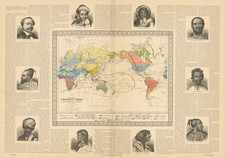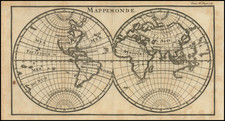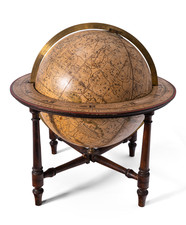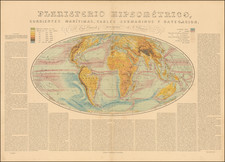Francesco Marmocchi's 1840 Earth Model: A Scholarly Cartographic Analysis
This model of the Earth, meticulously crafted by Francesco Marmocchi in Florence, represents an intricate and scholarly depiction of terrestrial climates and zones. Marmocchi, a notable geographer of the 19th century, created this model to elucidate the Earth’s climatic divisions in relation to celestial and terrestrial coordinates.
The early 19th century was a period of significant advancement in the field of geography and cartography. During this time, scholars were increasingly focused on understanding the Earth's physical characteristics and their relationship to astronomical phenomena. Marmocchi, through his detailed and precise work, contributed to this intellectual tradition, bridging the gap between empirical observation and scientific theory.
The model is circular, divided into various segments that represent different climatic zones and the corresponding zodiacal signs. The outer edge of the circle delineates degrees of latitude, extending from the polar regions to the equator. The central axis is aligned with the Earth's ecliptic and world axes, showcasing the tilt of the Earth in relation to its orbit around the Sun.
The map is color-coded to distinguish between the polar, temperate, and tropical zones. Each zone is further subdivided into specific climatic regions, marked with detailed annotations in Italian. Notably, the model incorporates the signs of the zodiac, aligning them with the Earth's climatic zones to illustrate the intersection of astronomical and terrestrial influences.
Marmocchi's model serves as an educational tool, providing a visual representation of the Earth’s climatic divisions. It exemplifies the 19th-century endeavor to integrate geographical knowledge with astronomical observations. By correlating climatic zones with zodiacal signs, Marmocchi highlights the perceived relationship between celestial movements and terrestrial climates, a concept that was pivotal in historical climatology and geography.
This model is a testament to the sophistication of 19th-century cartographic methods and the era's scientific curiosity. Marmocchi's work is a fine example of the period's attempt to encapsulate complex geographical and astronomical data into a coherent, visually engaging format. It reflects the broader intellectual currents of the time, wherein mapping the Earth was not only a geographical exercise but also an exploration of humanity's place within the cosmos.












![Western Hemisphere | Eastern Hemisphere [2 sheets]](https://storage.googleapis.com/raremaps/img/small/85676.jpg)

